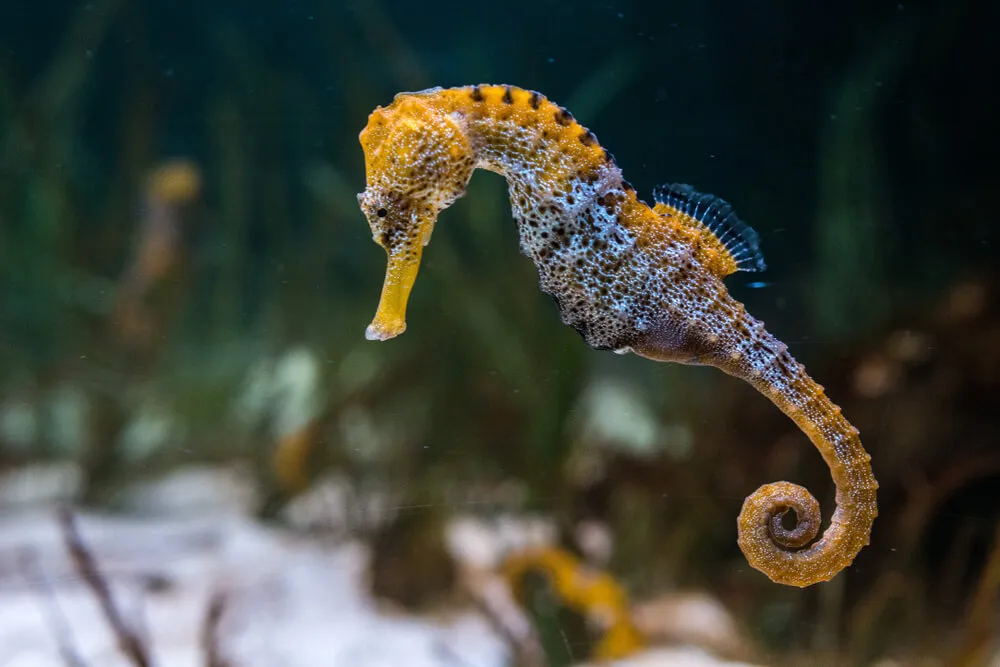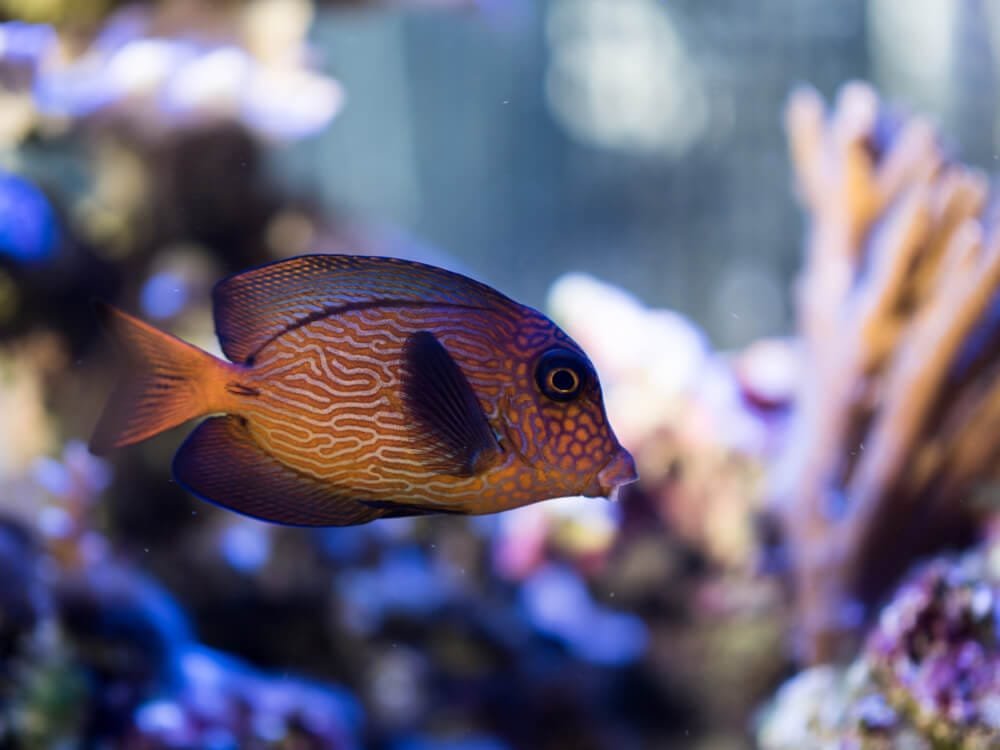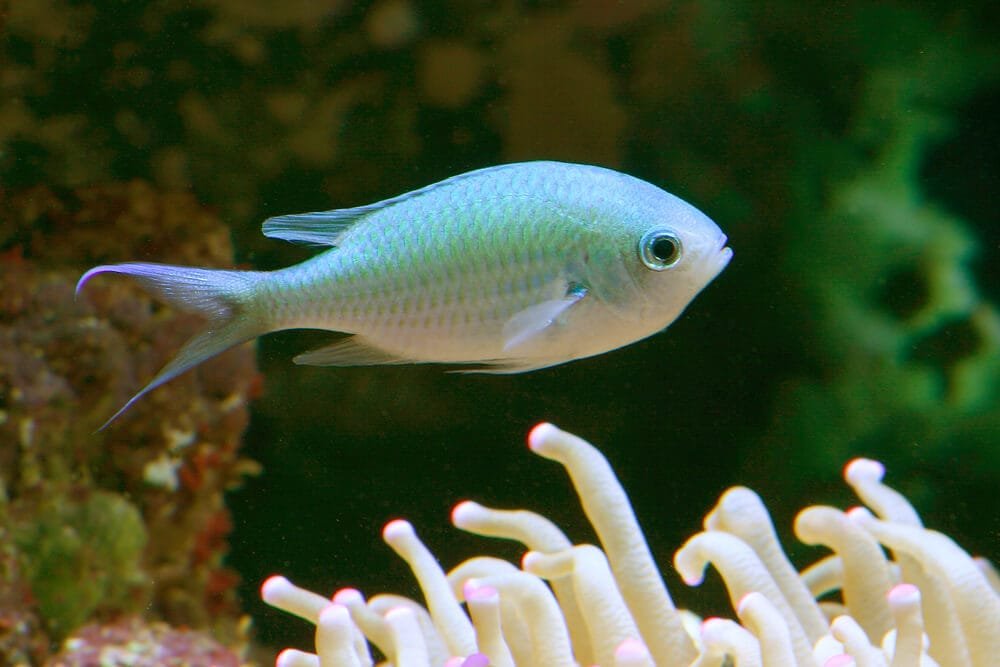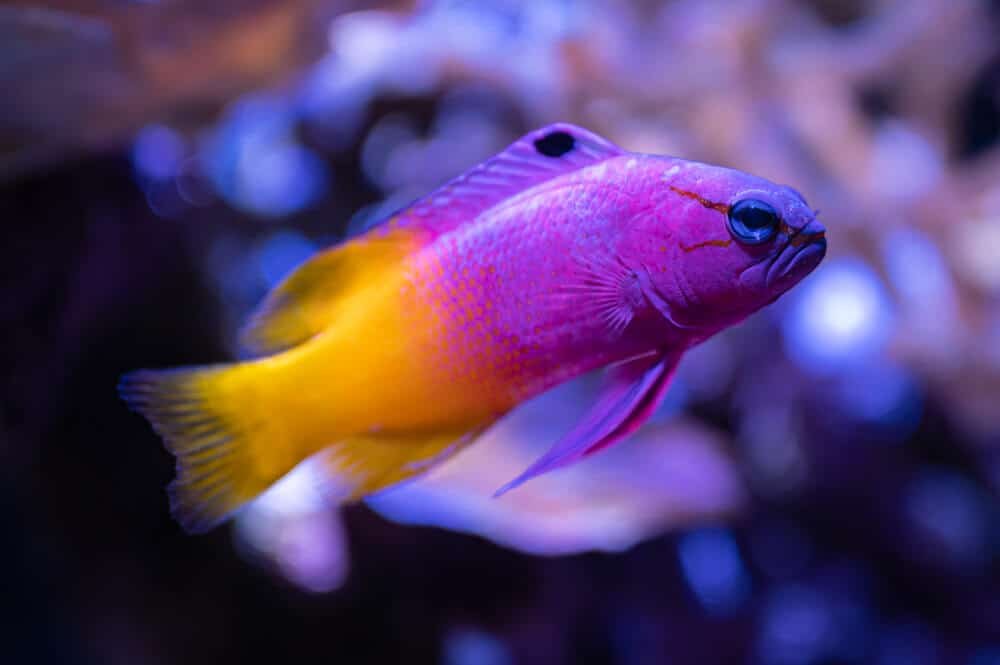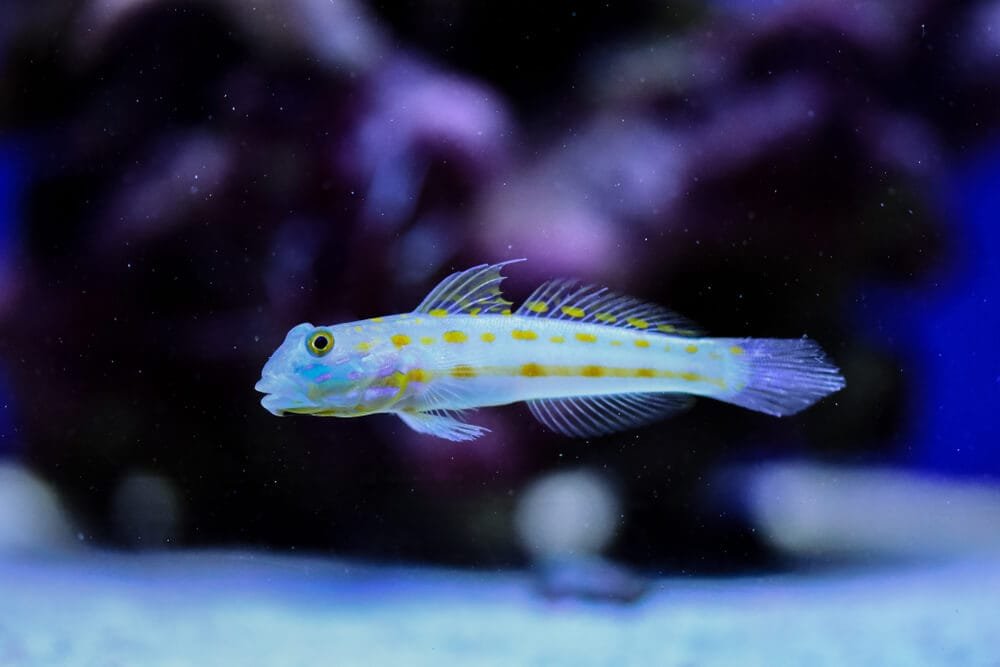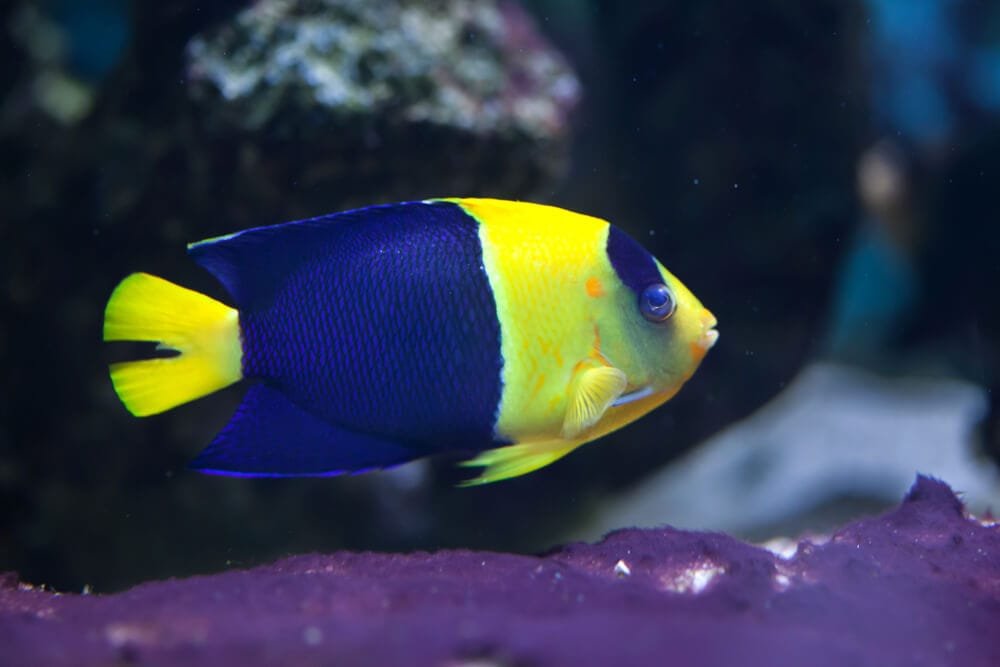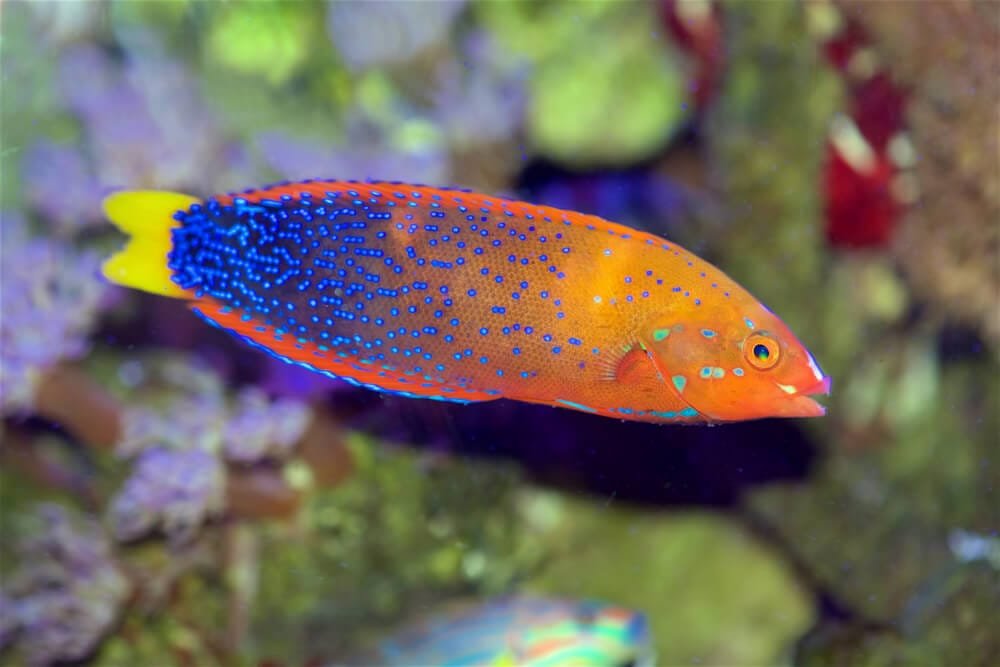A Guide To Raising Happy And Healthy Emperor Angelfish
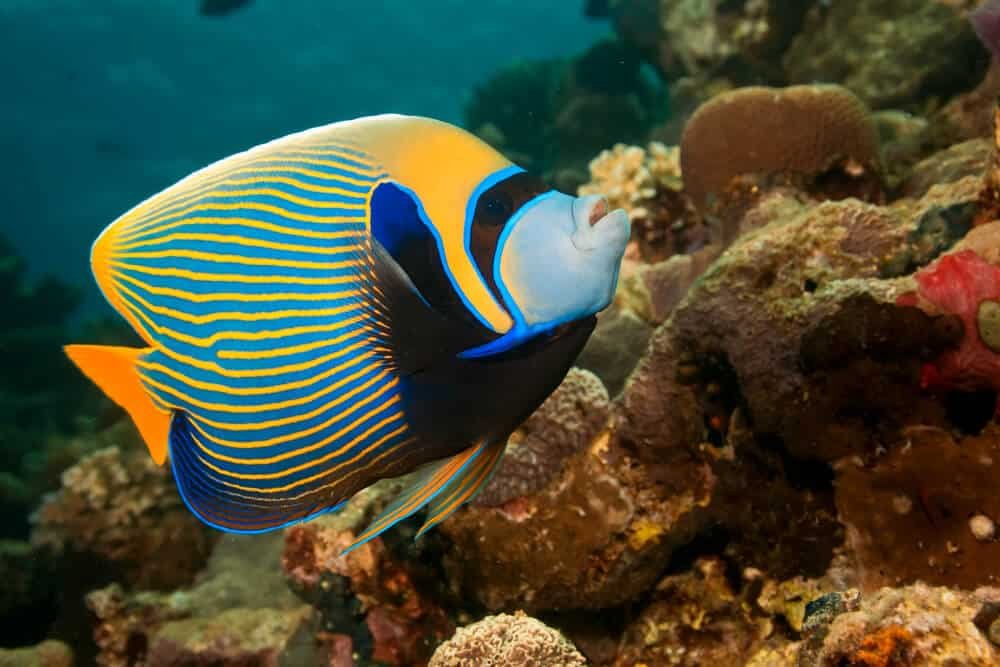
Species Overview
Common Names: Emperor Angelfish, Imperator Angelfish, Imperial Angelfish
Scientific Name: Pomacanthus imperator
Adult Size: 12 inches (in captivity); 15 inches (in the wild)
Life Expectancy: 20+ years
Characteristics
Family: Pomacanthidae
Origin: Indo Pacific Ocean
Social: Semi-aggressive
Minimum Tank Size: 125 gallons (juveniles); 200 gallons (adults)
Diet: Omnivore
Breeding: Egg-laying
Care: Moderate to difficult
pH: 8.1 to 8.4
Hardness: 8 to 12 dKH
Temperature: 72 to 82 degrees Fahrenheit
Emperor Angelfish Overview
- Size: 12 inches (in captivity); 15 inches (in the wild)
- Minimum Tank Size: 125 gallons (juveniles); 200 gallons (adults)
- Temperament: Semi-aggressive
- Diet: Omnivore
- Care Level: Moderate to difficult
This fish species is said to be one of the most recognizable fishes internationally based on the numerous photographers that have captured pictures of it. From the name ‘emperor’, you can expect that this fish is extraordinary.
This fish species was discovered in the late 18th century and since then, it was featured heavily in countless magazines, books, and TV shows. Its bright coloration is one of the main reasons for its attractive appearance.
They can grow very large even in captivity, measuring almost up to 12 inches. Therefore, having a spacious fish tank that can contain more than a hundred gallons of water is a must.
Taking care of this fish type might require more attention because of its moderate to difficult care level, but it can also be a good investment.
It can live for more than 20 years, and you can have it breed, if possible, multiple times within its lifetime.
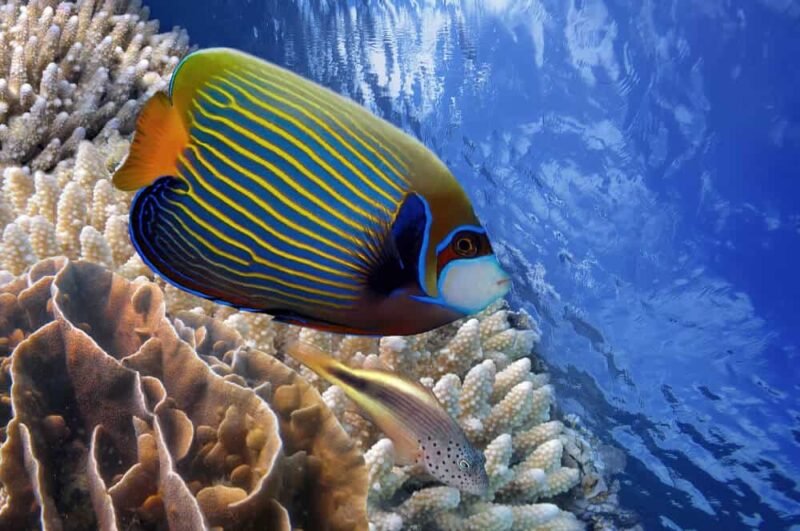
Origin
This fish type is native to the Indo-Pacific Region. If you haven’t known about that, the water region refers to the majority of the Indian Ocean and the Pacific Ocean and stretches from the Eastern shores of Africa all the way to Hawaii.
With such a vast natural distribution, anyone living in the countries nearby like Madagascar, India, Indonesia, and Australia can find this fish species.
There are even instances that it can be also found in Japan and in Florida, which are places beyond the Indo-Pacific Region.
Emperor Angelfish can swim very deeply, from 3.3 to 328.1 feet. The adult ones can settle inside the underwater caves and ledges while the juveniles prefer where meals are plentiful.
There can be many variations or relatives of this fish.
There is the “French Angelfish” found in the Atlantic Ocean, the “Queen Angelfish” which is a female that can release 10 million eggs in a single spawning, the “Barred Angelfish” in which its mating ritual is one of the longest, and the “Bellus Angelfish” known for its pearlescent body.
Habitat / Availability
These species are made up of saltwater fishes that can survive both in the wild and in captivity. Given that it can grow over a foot long, a large tank is must for it to survive healthily.
However, this fish type needs more attention in order to live longer. Their high care level contributes to the difficulty of setting up an appropriate tank.
Fortunately, since its temperament is only semi-aggressive, there can be many compatible types of fishes to be its tank mates. Also, its omnivore diet makes it a helpful factor for its compatibility with other fishes.
This fish species may have a vast distribution and large population in the wild, but it can be a bit costly to purchase one on pet stores or online shops.
A juvenile can cost between $129 to $199, while a sub-adult can cost around $239 and an adult can cost $399 to $1,400.
Appearance
This fish species is renowned for its beautiful appearance, but its transformation from juvenile to adult is quite dramatic.
In fact, the juvenile is thought to be a different species from that of its adult counterpart before the late 1930s.
The juvenile Emperor Angelfishes have black bodies covered with C-shaped bands. They have typically 3 thick white bands and in between them are thinner sapphire blue bands.
As the fish enters the stage of being a sub-adult, it gradually undergoes a lot of changes such as the fading of the juvenile colors. Usually after 2 years, the fish will become a full-grown adult.
The adults have horizontal stripes comprising of the colors yellow and blue. The stripes stretch from the tip of the gills to the tail, and a dark mask-like band is formed that covers the eye area.
Furthermore, the adult gains a lot of colored patterns like having a light green-yellow nape, a yellow tail fin, a white coloration at the dorsal fin’s tip, and a shade of blue stripes at the anal fin.
As the fish become adults, their bodies become longer and rounder.
To differentiate between male and female Emperor Angelfishes, you have to look closely at their colors. The male fish has darker colors especially in the face, while the female one tends to look a bit less vibrant.
Size
The fish can grow up to 12 inches in captivity and 15 inches in the wild. However, having the fish grow to its optimum length while being captive can be pretty rare.
Knowing that the care level is between moderate to difficult, it can take a lot of effort to provide the best enclosed environment for your pet.
Planning is the key to success if you want this type of fish reach its maximum size during adulthood.
Male adults are a bit larger than the female adult ones. Even though the size of this fish can vary, the more important quality is the color patterns and also the corresponding health condition.
Behavior / Temperament
This type of fish is a semi-aggressive creature. It has tendencies to battle other fishes, either from different species or from the same specie.
The temperament of this fish species is due to its territorial nature. Having two adult males inside a fish tank is prohibited since they can end up fighting until only one of them survived.
The size of Emperor Angelfish also influences its behavior.
Compared to most fishes that are suited for the community tank environment, this fish type is much larger, and this can enable them to bully smaller and peace-loving fishes.
They can even bully other angelfishes with similar profile. When it comes to food, they can eat anything since they are omnivores, but they tend to be shy at first instead of scavenging for food.
That can only last for a while. Once they become more comfortable with their environment, they will be greedier for territory and for food.
Lifespan
Even in captivity, this can live for more than 20 years. That goes to show that it can live much longer in the wild.
The key in helping this fish live up to its optimum age is to provide it with a stress-free environment. However, the difficult part is providing such an environment since this fish is sensitive to the conditions of the water.
To guide you, you need to know the care level and tank requirements for this fish species. Furthermore, you can have a pair of them breed only if you can maintain the almost impossible breeding conditions.
Care Level
A fish that grows more than a foot, with a semi-aggressive temperament, and a majestic coloration that can be affected by stress, definitely makes caring for it a challenge.
Emperor Angelfishes are not easy to take care of and they are not for the beginner fish groomers.
Aside from knowing the tank requirements, you have to be familiar with the possible diseases and parasites that the fish might have.
Moreover, knowing which creatures are suitable tank mates and not can ease your worries in setting up a community tank.
Common Possible Parasites And Diseases
Although this type of fish are hardy and can survive the wild as vast as the two oceans, it can be easily susceptible to diseases and parasites.
The most common are Ich or White Spot Disease, Marine Velvet, and Head and Lateral Line Erosion Disease.
Ich / White Spot Disease
Caused by a parasite, Ich affects the fish through the appearance of noticeable tiny white spots on the fin and skin.
For the fishes, this is too itchy and oftentimes it makes them decide to crash their bodies against rocks in order to relieve themselves.
Ich is also common to other tropical fishes and so, the best solution in order to prevent the spread is isolating the affected fishes.
While you are sanitizing the main fish tank, treat the affected fishes with copper until the white spots disappear.
Head and Lateral Line Erosion
This disease has a much unattractive effect on the fish compared to Ich. The Head and Lateral Line Erosion disease is also called as “hole-in-the-head” disease.
That other name is due to the literal description of the disease, wherein the lateral line organ and skin on the face have erosive lesions forming.
This is caused by parasites, activated carbon, carbon dust, or nutrient deficiencies.
Fortunately for this fish species, the treatment for such disease can be an anti-parasitic medication. Also, it is claimed that bright lighting for the fish tank can help in avoiding or recovering from the disease.
Marine Velvet
Marine velvet is also another parasitic disease wherein the fish has golden spots on the bodies and gills, similar to that of Ich. The difference is that the spots can be inflamed and bleeding can take place.
One common treatment for the ailment is using copper, similar also to that for Ich. It is recommended to quarantine the affected fish while the treatment is ongoing.
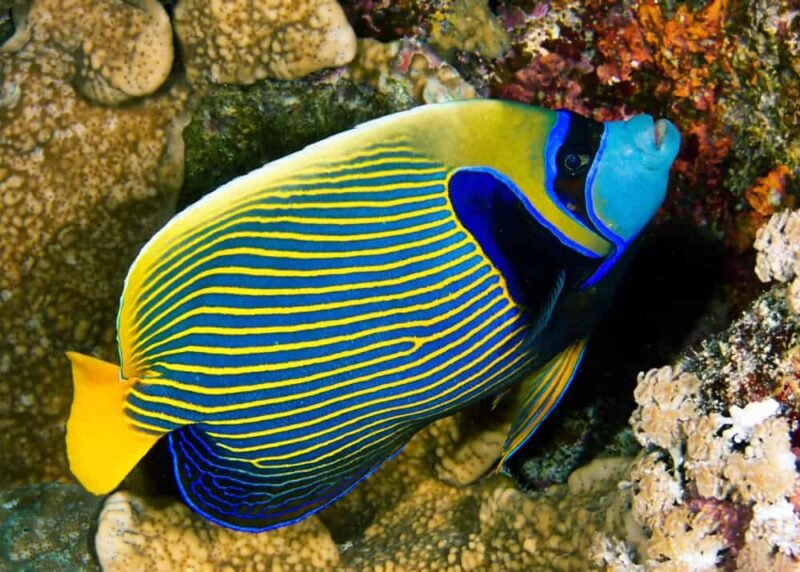
Tank Requirements
It is already established that it can be difficult to take care of this fish species. The key in making it manageable is preparation, and that is why knowing the tank requirements beforehand is a must.
Since Emperor Angelfish is a saltwater fish, it is understandable that replication of the water conditions of the ocean is the most preferable. However, that can end up costing you a lot.
Tank Size
One of the first things you must look at when taking care of your fish is the tank. Here are the required tank parameters:
- Tank Size (Minimum): 200 gallons for adults; 125 gallons for juvenile
- Tank Setup: Plants, caves, lighting, rockwork,
This fish type used to live in the Indian Ocean and the Pacific Ocean. With that large natural habitat, it is logical that this fish requires a lot of space in the fish tank.
The minimum tank size indicated above for adults are either for a single fish or a suitable pair (1 male and 1 female). For the minimum tank size of the juvenile, the 125 gallons is for a single fish only.
A harem, which consists of 1 male and multiple females, is possible but needs a much larger tank.
On the other hand, 1 adult male Emperor Angelfish cannot be put in the same tank with another male due to their highly competitive nature.
Substrates are required but overcrowding with ornaments can be disadvantageous to the fish. Plants can serve as shade and food also since the fish is an omnivore.
Water Parameters
In order to maintain the fish tank as an appropriate environment for the fish, here are the water parameters you must seek to achieve:
- Water Type: Saltwater, preferably slow-moving
- Temperature: 72 to 82 degrees Fahrenheit
- pH Levels: 1 to 8.4
- Hardness: 8 to 12 dKH
- Specific Gravity: 020 to 1.025
In order to practice maintaining the water parameters, it will be helpful to build the fish tank weeks or months before placing the fish in. In that way, you can get more familiar with the necessary routine.
Including in your water maintenance routine is the semi-annual cycling of your tank. This means you have to change the water inside the fish tank and replace with a fresh batch.
Additionally, having a strong filtration system is advantageous to achieve the water parameters accurately. It can also help in regulating the waste and prevent the fish from catching diseases.
Increasing the water temperature to 82 degrees Fahrenheit can help in stopping parasites from attaching themselves to the fish.
Furthermore, changing 15 percent of the water every 2 weeks can help prevent diseases, and if there are corals in the tank, you only have to do a 10-percent water change.
Substrate
Emperor Angelfish loves to hide when it is still unfamiliar with the environment. As mentioned, the adults prefer to settle in underwater caves if they are in the wild.
For that reason, adding rocks and artificial caves can be beneficial to this fish. When you add rocky components, make sure there are no sharp edges to avoid any injury.
If you plan to add corals, choose small-polyped stony corals, disc anemone, bubble corals, star polyps, or hammer corals. This is because this fish has the capability to feed on soft and stony corals.
When adding plants, you have to add only the natural ones in order to recreate the wilderness environment.
The amount of flora is preferred to be plentiful since they can act as sources of oxygen and casual food options.
Lighting
Lighting is important when having a fish tank, especially for tropical fishes. Since Emperor Angelfish is a tropical fish, it needs bright light to stay healthy.
The lighting can contribute to enhancing their coloration. Furthermore, it can also prevent from acquiring ailments like Head and Lateral Line Erosion disease.
It will be better to set up a reef-like lighting. This can mimic the lighting conditions of the this fish’s natural habitat.
Equipment
The most important equipment in your fish tank is the filtration system. Not only does it maintain the required water parameters, but it also keeps the water environment safe and clean.
This fish species is very sensitive and therefore, there is a strict demand for water maintenance. And since it used to living in the vast ocean, the oxygenation level of the tank’s filter must be well-monitored.
If you want to add more equipment that can ease the workload of the filter, you can choose to add a UV sterilizer and a protein skimmer. These can also help to create a healthy tank environment.
For added security, you can also install a tank lid. Not only it will prevent other animals in preying on Emperor Angelfish, but it will also help in preventing it from jumping out of the aquarium.
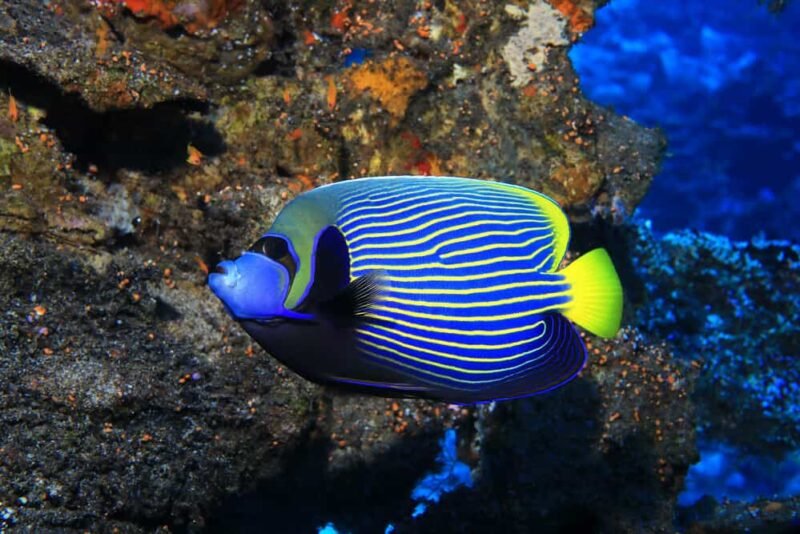
Food And Diet
It might be relatively easy to feed this fish species since they are omnivores. Even in the wild, they are said to be the “cleaner fishes” since they can practically eat anything, even stony corals.
At first, Emperor Angelfishes can get shy and afraid to consume food. You can introduce them to generic foods like algae or commercial fish food.
As they gain confidence and start to swim around the tank, you can proceed in feeding them foods that are rich in protein. You can also start to increase the feeding frequency if they become big eaters.
However, you must limit the feeding to 5 minutes at a time only in order to prevent contaminating the tank water from the uneaten food. To guide you in feeding, here are the common foods it likes to eat:
- Spirulina
- Marine algae
- Squid
- Shrimp
- Clams
- Scallops
- Sponge (Porifera)
- Spinach
- Flake food
- Pellets or tablets
- Corals
- Dried seaweed
Breeding
Breeding in captivity can be really difficult for this type of fish. In the wild, the male and female fishes only spawn within a short period at the later time of the year.
When ready, the pair will rise near the water’s surface. Then, the female will distribute the eggs by having them drift safely in the strong current.
You may be able to replicate such conditions only when you have an extremely large aquarium with a stress-free environment.
Since this is impractical, it is said to be impossible to breed this type of fish species inside a usual fish tank.
Tank Mates / Compatibility
In the wild, it is normal to see Emperor Angelfishes by twos or threes. In captivity, the situation can be different since they tend to adapt to the limited size of the fish tank.
Because of that, this fish species can become more territorial and greedier during feeding time. In captivity, a juvenile and an adult can be kept together.
As the juvenile grows to be an adult, the other adult might get insecure and therefore, it is advisable to separate them both.
But if the two adult Emperor Angelfishes are from separate genders, it is okay to pair them together.
This fish type has a semi-aggressive temperament, as previously mentioned.
It is important that their tank mates do not put stress on them because it can affect their coloration, especially the ones who are still growing.
Since this fish is significantly larger, it can bully the smaller, peaceful types. Some experts advise to put the Emperor Angelfish last in the order when relocating the fishes in a community tank.
Additionally, for other angelfishes similar to this fish species, the guide mentioned above is also applicable, especially the part between the adult-juvenile relationship and the male-female pairing.
Here are a number of suitable tank mates for the fish:
- Flame, swallowtail coral beauty, angelfish
- Tangs
- Dottybacks
- Six-line and 8-line wrasse
- Large wrasses
- Damselfish
- Butterflyfish
- Lionfish
- Groupers
- Rabbit snails
- Pufferfish
- Starfish
- Mini brittle stars
- Amphipods
- Copepods
Here is also a list of creatures that are unsuitable to be Emperor Angelfish tank mates:
- Fairy wrasses
- Gobies
- Dartfish
- Dwarf angels
- Assessors
- Anthias
- Seahorses
- Clownfish
- Pipefish
- Mandarins
- Sea fans
- Snails
- Crabs
- Shrimp
- Clams
- Oysters
- Scallops
- Anemones
- Sea stars
Frequently Asked Questions
Is this type of fish easy to keep?
They are not easy to keep since the care level is from moderate to difficult. You need to constantly provide a great environment and maintain the water parameters in order to keep them healthy.
How fast do Emperor Angels grow?
Within the 24th and 30th month, the Emperor Angelfishes can acquire their adult coloration. If they are in the wild, the size of a full adult is around 15 inches; meanwhile, if they are in captivity, they can only reach 12 inches.
How do you know angelfish are happy?
There can be signs indicating that an angelfish, particularly this type of angelfish, is happy. Here are the following:
- Swims actively
- Has healthy appetite
- Has clear, normal eyes
- Has fins not clamped but flared out
- Has vibrant scale colors
- Has no diseases
- Has no abnormal growth
Conclusion
This fish species is not an easy fish to take care of. However, if you are up to the task, you’ll have one of the most beautiful and brightly colored aquatic creatures as your pet.
When handling this type of fish species, make sure you fulfill the tank and water requirements and have a routine when doing maintenance and feeding.
If you find it difficult, always seek the help of an expert in order to keep your Emperor Angelfish healthy and happy.
